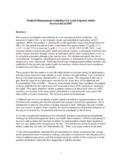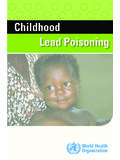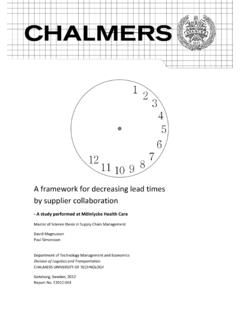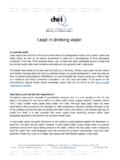Transcription of PART II - WHO
1 PPAARRTT IIIIE valuating the public health significance ofmicronutrient 14/11/06 16:43 Page 14/11/06 16:43 Page 40 IntroductionThe chapters in part II of these guidelines provide more detailed backgroundinformation on the prevalence, causes and health consequences of variousmicronutrient deficiencies, and review the available evidence regarding the ben-efits of their control. They are intended to assist planners not only in their eval-uation of the micronutrient deficiency situation in their own country, but alsoto assess the need for, and potential benefits of, food fortification with 3 looks at iron, vitamin A and iodine deficiencies, which, owing totheir widespread occurrence globally, have received the most attention to large amount of information is now available regarding the prevalence, thecauses and the control of deficiencies in these three micronutrients.
2 Variousstudies on the efficacy and effectiveness of interventions to control deficienciesin iron, vitamin A and iodine, are briefly described here (and in the openingchapter of this document; see section ), but are reviewed in greater depthelsewhere (73). Chapter 4 focuses on a range of other micronutrients, which, incomparison, have hitherto been somewhat neglected. Deficiencies in at leastsome of these neglected micronutrients ( in zinc, vitamins B2and B12,niacin, vitamin D and calcium) are likely to be common throughout much ofthe developing world and among the poorest populations in the industrializednations. Fortification provides a means of lowering the prevalence of deficien-cies in all of these micronutrients, and their inclusion in mass fortification pro-grammes, in particular, could produce significant public health benefits.
3 Sincethere is less information about these micronutrient deficiencies in the literature,a concerted effort has been made to summarize what is known about them inthese both chapters, micronutrients are discussed in order of their perceivedpublic health significance, and in each case the recommended or the most com-monly used biochemical status indicators are critically reviewed. For somemicronutrients, however, biochemical data reflecting nutritional status will beinadequate for assessing the prevalence of deficiencies. Suggestions for dealingwith this situation, for example, by using food intake data to estimate the preva-lence of inadequate intakes, are provided in part IV of these guidelines (seesection ). 14/11/06 16:43 Page 41 Other than a low dietary intake, important causes of MNM include poorbioavailability from foods (especially for minerals), frequent infection with par-asites, diarrhoea, and various malabsorption disorders.
4 The presence of any ofthese risk factors can lead to an underestimation of the prevalence of deficiencyin a population if this is calculated on the basis of micronutrient intakes factors for micronutrient malnutrition Monotonous diet resulting in low micronutrient intake, and poor bioavailability, espe-cially of minerals. Low intake of animal source foods. Low prevalence of breastfeeding. Low micronutrient density of complementary foods. Increased physiological demands for growth during pregnancy and lactation. Increased demand due to acute infection (especially if infection episodes are fre-quent), chronic infection ( tuberculosis, malaria and HIV/AIDS) and disease ( ). Poor general nutritional status, in particular, protein energy malnutrition. Malabsorption due to diarrhoea or the presence of intestinal parasites ( , hookworms). Increased excretion ( due to schistosomiasis).
5 Seasonal variations in food availability, food shortages. Social deprivation, illiteracy, low education. Poor economic status and ON FOOD FORTIFICATION WITH 14/11/06 16:43 Page 42 CHAPTER 3 Iron, vitamin A and Iron deficiency and anaemiaMost of the iron in the human body is present in the erythrocytes as haemo-globin, where its main function is to carry oxygen from the lungs to the is also an important component of various enzyme systems, such as thecytochromes, which are involved in oxidative metabolism. It is stored in the liveras ferritin and as deficiency is the most common and widespread nutritional disorder in the world, and is a public health problem in both industrialized and non-industrialized countries. Iron deficiency is the result of a long-term negative ironbalance; in its more severe stages, iron deficiency causes anaemia.
6 Anaemia isdefined as a low blood haemoglobin concentration. Haemoglobin cut-off valuesthat indicate anaemia vary with physiological status ( age, sex) and have beendefined for various population groups by WHO (1). Prevalence of deficiencyThe terms, iron deficiency and iron-deficiency anaemia are often used syn-onymously although they are in fact not the same conditions. About 40% of theworld s population ( more than 2 billion individuals) is thought to suffer fromanaemia, low blood haemoglobin (see Table ).The mean prevalencesamong specific population groups are estimated to be: pregnant women, infants and children aged 1 2 years, 50%; preschool-aged children, 25%; schoolchildren, 40%; adolescents, 30 55%; non-pregnant women, 35%.These average figures obscure the fact that iron deficiency and iron-deficiencyanaemia are even more prevalent in some parts of the world, especially in theIndian subcontinent and in sub-Saharan Africa, where, for example, up to 90%of women become anaemic during 14/11/06 16:43 Page 43 The prevalence of anaemia caused by iron deficiency, usually referred to asiron-deficiency anaemia, is less certain because the specific indicators of ironstatus, such as serum ferritin, transferrin saturation, zinc protoporphyrin andserum transferrin receptors, are measured less often than blood haemoglobin(Table ).
7 Most indicators of iron status with the possible exception of serumtransferrin receptors are also affected by the presence of infection and cantherefore be misleading (74). Indeed, every indicator listed in Table has itsown set of limitations, and so iron status is best assessed by a combination ofindicators (74).It is generally assumed that, on average, around 50% of the cases of anaemiaare due to iron deficiency, as opposed to malaria (which causes anaemia becausethe malaria parasite destroys erythrocytes), the presence of infection or othernutrient deficiencies. However, the proportion is probably higher in infants andpreschool-aged children than in older children or women (75), and is likely tovary by location. Although anaemia usually occurs when iron stores are depleted,the prevalence of iron deficiency will often be substantially higher than theprevalence of iron-deficiency anaemia.
8 However, in iron-deficient populationswith endemic malaria, the prevalence of anaemia will be greater than, or similarto, the prevalence of iron deficiency (75). Furthermore, the use of serum fer-ritin as an indicator of iron status may well overestimatethe prevalence of irondeficiency in malaria endemic areas; this is because serum ferritin levels are ele-vated by the presence of infections such as malaria (Table ), and also thereason why, traditionally, the cut-off level that defined iron deficiency in indi-viduals with malaria was higher (<30 g/l) than that used for individuals freefrom infection (<15 g/l).Anaemia is considered to be a public health problem when the prevalence oflow haemoglobin concentrations exceeds 5% in the population (1). The sever-ity of the public health problem of anaemia is classified as mild, moderate orsevere according to the prevalence of anaemia (Table ).
9 Risk factors for deficiencyThe main risk factors for iron deficiency have been summarized in Ta ble include: a low intake of haem iron (which is present in meat, poultry and fish); an inadequate intake of vitamin C (ascorbic acid) from fruit and vegetables(the presence of vitamin C enhances the absorption of iron from the diet); poor absorption of iron from diets high in phytate (including legumes andcereals) or phenolic compounds (present in coffee, tea, sorghum and millet);GUIDELINES ON FOOD FORTIFICATION WITH 14/11/06 16:43 Page 443. IRON, VITAMIN A AND IODINE45 TABLE for assessing iron status at the population levelaIndicatorSamplePopulation groupCut-off to defineCommentsdeficiencyMildSevereHaemog lobinbBloodChildren 6 59 months110 g/lNot definedBlood haemoglobin is primarily an indicator of anaemia but canChildren 5 11 years115 g/lprovide useful information regarding iron status, as follows:Children 12 14 years120 g/l An increase of at least 10 g/l in blood haemoglobin afterMen over 15 years130 g/l1 or 2 months of iron supplementation is indicative ofWomen over 15 years120 g/lbaseline iron deficiency.
10 (non-pregnant) Where poor availability of dietary iron is the main causePregnant women110 g/l<70 g/lof anaemia, children and women have disproportionatelylow haemoglobin values, while those of adult men arevirtually unaffected. Where other factors, such asparasites, contribute significantly, adult men are morelikely to also have low haemoglobin orUnder 5 years<12 g/lNot definedUseful indicator of iron status and also for monitoringplasmainterventions for iron 5 years<15 g/lNot definedReflects total body iron stores and is decreased in in the presence of infection or inflammatory processand should thus be measured, if possible, in combinationwith another acute phase protein (CRP or AGP), whichindicate the presence of of >200 g/l in adult males (or 150 g/l in adultfemales) indicates severe risk of iron 14/11/06 16:43 Page 45 GUIDELINES ON FOOD FORTIFICATION WITH MICRONUTRIENTS46 TABLE for assessing iron status at the population levela(Continued)IndicatorSamplePopulati on groupCut-off to defineCommentsdeficiencyMildSevereTransf errinSerumCan be applied to allCut-off values vary Useful indicator of iron status; not affected by infection and receptorspopulation groupswith method usedthus can be used in combination with measurement of serumferritin to confirm deficiency in cases of universally agreed cut-offs; reference materials still need tobe be applied to all<16%Not definedPronounced diurnal variation and not very groupsElevated in the presence of universally agreed 5 yearsNormal>70 g/dlElevated when iron supply is inadequate for haem (RBC)Over 5 yearsNormal>80 g/dlElevated in the presence of infection, lead poisoning andhaemolytic anaemia.














